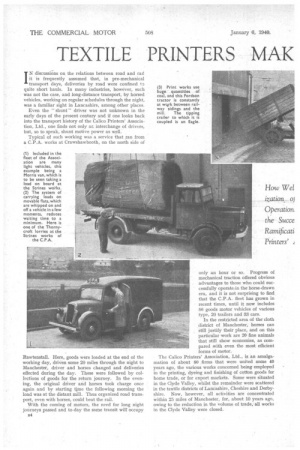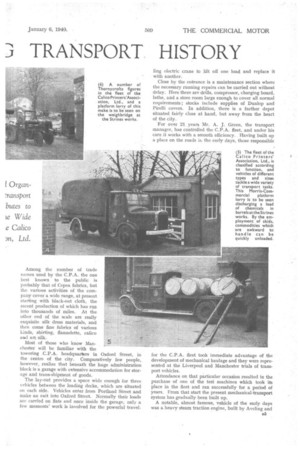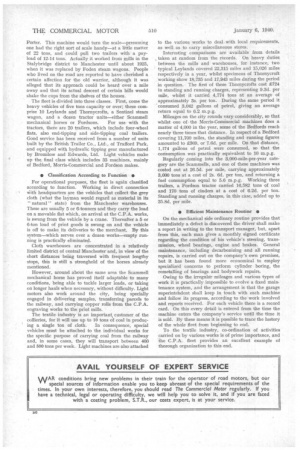TEXTILE PRINTERS MAK 3 TRANSPORT HISTORY
Page 30

Page 31

Page 32

If you've noticed an error in this article please click here to report it so we can fix it.
IN discussions on the relations between road and rail it is frequently assumed that, in pre-mechanical transport days, deliveries by road were confined t.) quite short hauls. In many industries, however, such was not the case, and long-distance transport, by horsed vehicles, working on regular schedules through the night, was a familiar sight in Lancashire, among other places.
Even the " shunt " driver was not unknown in the early days of the present century and if one looks back into the transport history of the Calico Printers' Association, Ltd., one finds not only ar_ interchange of drivers, but, so to speak, shunt motive power as well.
Typical of such working was a service that ran from a C.P.A. works at Crawshawbooth, on the north side of Rawtenstall. Here, goods were loaded at the end of the working day, driven some 20 miles through the night to Manchester, driver and horses changed and deliveries effected during the day. These were followed by collections of goods for the return journey. In the evening, the original driver and horses took charge once again and by starting time the following morning the load was at the distant mill. Thus organized road transport, even with horses, could beat the rail.
With the coming of motors, the need for long night journeys passed and to-day the same transit will occupy
only an hour or so. Progress of mechanical traction offered obvious advantages to those who could successfully operate in the horse-drawn era, and it is not surprising to find that the C.P.A. fleet has grown in recent times, until it now includes 56 goods motor vehicles of various type, 20 trailers and 33 cars.
In the restricted area of the cloth district of Manchester, horses can still justify their place, and on this particular work are 20 fine animals that still show economies, as compared with even the most efficient forms of motor.
The Calico Printers' Association, Ltd., is an amalgamation of about 80 firms that were united some 40 years ago, the various works concerned being employed in the printing, dyeing and finishing of cotton goods for home trade, or for export markets. Some were situated in the Clyde Valley, whilst the remainder were scattered in the textile districts of Lancashire, Cheshire and Derbyshire. Now, however, all activities are concentrated within 25 miles of Manchester, for, about 10 years ago, owing to the reduction M the volume of trade, all works in the Clyde Valley were closed.
Among the number of trade names used by the C.P.A. the one best known to the public is probably that of Cepea fabrics, but the various activities of the company cover a wide range, at present starting with black-out cloth, the recent production of which has rim into thousands of miles. At the other end of the scale are really exquisite silk dress materials, and then come fine fabrics of various kinds, shirting, flannelette, calico mad art silk.
Most of those who know Manchester will be familiar with the towering C.P.A. headquarters in Oxford Street, in the centre of the city. Comparatively few people, however, realize that beneath the huge administration block is a garage with extensive accommodation for storage and trans-shipment of goods.
The lay-out provides a space wide enough for three vehicles between the loading decks, which are situated on each side. Vehicles enter from Portland Street and make an exit into Oxford Street. Normally their loads are carritd on flats and once inside the garage, only a few moments' work is involved for the powerful travel
ling electric crane to lift off one load and replace it with another.
Close by the entrance is a maintenance section where the necessary running repairs can be carried out without delay. Here there are drills, compressor, charging board, lathe, and a store room large enough to cover all normal requirements ; stocks include supplies of Dunlop and Pirelli covers. In addition, there is a further depot situated fairly close at hand, but away from the heart of the city.
For over 21 years Mr. A. J. Green, the transport manager, has controlled the C.P.A. fleet, and under his care it works with a smooth efficiency. Having built up a place on the roads in the early days, those responsible
for the C.P.A. fleet took immediate advantage of the development of mechanical haulage and they were represented at the Liverpool and Manchester trials of transport vehicles.
Attendance on that particular occasion resulted in the purchase of one of the test machines which took its place in the fleet and ran successfully for a period of years. From that start the present mechanical-transport system has gradually been built up.
A notable, almost famous, vehicle of the early days was a heavy steam traction engine, built by Aveling and sa Porter. This machine would turn the scale—presuming one had the right sort of scale handy—at a little matter of 22 tons, and could pull two trailers with a payload of 12-14 tons. Actually it worked from mills in the Stalybridge district to Manchester until about 1925, when it was replaced by Foden steam wagons. People who lived on the road are reported to have cherished a certain affection for the old warrior, although it was alleged that its approach could be heard over a mile away and that its actual descent of certain hills would shake the cups from the shelves of the houses.
The fleet is divided into three classes. First, come the heavy vehicles of five tons capacity or over; these comprise 10 Leylands and Thornycrofts, a Sentinel steam wagon, and a dozen tractor units—either Scammell mechanical horses or Fordsons. For use with the tractors, there are 20 trailers, which include four-wheel flats, also end-tipping and side-tipping coal trailers. Good service has been received from a number of units built by the British Trailer Co., Ltd., of Trafford Park, and equipped with hydraulic tipping gear manufactured by Bromilow and Edwards, Ltd. Light vehicles make up the final class which includes 33 machines, mainly of Bedford, Morris-Commercial and Fordson makes.
• Classification According to Function •
For operational purposes, the fleet is again classified according to function. Working in direct connection With headquarters are the vehicles that collect the grey cloth (what the layman would regard as material in its " natural " Mate) from the Manchester warehouses. These are usually 5 or 6-tonners and they carry the load on a movable flat which, on arrival at the C.P.A. works, is swung from the vehicle by a crane. Thereafter a 5 or 6-ton load of print goods is swung on and the vehicle is off to make its deliveries to the merchant. By this system—which serves over a dozen works—empty running is practically eliminated.
Cloth warehouses are concentrated in a relatively limited district of central Manchester and, in view of the short distances being traversed with frequent lengthy stops, this is still a stronghold of the horses already mentioned.
However, around about the same area the Scamrnell mechanical horse has proved itself adaptable to many conditions, being able to tackle larger loads, or taking on longer hauls when necessary, without difficulty. Light motors also work around the city, being specially engaged in delivering samples, transferring parcels to the railway, and carrying copper rolls from the C.P.A. engraving works to the print mills.
The textile industry is an important, customer of the collieries, for it will use up to 10 tons of coal in produc ing a single ton of cloth. In consequence, special vehicles must be attached to the individual works for the specific purpose of carrying coal from the railway and, in some cases, they will transport between 400 and 500 tons per week. Light machines are also attached to the various works to deal with local requirements, as well as to carry miscellaneous stores.
Interesting comparisons are available from details taken at random from the records. On heavy duties between the mills and warehouses, for instance, two typical Leylands covered 22,315 miles and 15,026 miles respectively in a year, whilst specimens of Thornycroft working show 18,735 and 17,943 miles during the period in question. The first of these Thbmycrofts cost 724 in standing and running charges, representing 9.3d. per mile, whilst it carried 4,774 tons at an average of approximately 3s. per ton. During the same period it consumed 3,042 gallons of petrol, giving an average return equal to 6.2 m.p.g.
Mileages on the city rounds vary considerably, so that whilst one of the Morris-Commercial machines does a matter of 4,000 in the year, some of the Bedfords reach nearly three times that distance. In respect of a Bedford covering 11,700 miles, the standing and running figures amounted to £369, or 7.6d. per mile. On that distance, 1,174 gallons of petrol were consumed, so that the consumption was practically equivalent to 10 m.p.g.
Regularly coming into the 3,000-mile-per-year category are the Scammells, and one of these machines was costed out at 26.5d. per mile, carrying approximately 3,000 tons at a cost of 2s. 6d. per ton, and returning a fuel consumption equal to 5.6 m.p.g. Working three trailers, a Fordson tractor carried 16,582 tons of coal and 170 tons of cinders at a cost of 6.2d. per ton. Standing and running charges, in this case, added up to 35.8d. per mile.
• Efficient Maintenance Routine • On the mechanical side ordinary routine provides that immediately a defect is discovered the driver shall make a report in writing to the transport manager, but, apart from this, each man gives a monthly signed certificate regarding the condition of his vehicle's steering, transmission, wheel bearings, engine and brakes. General maintenance, including decarbonizing and all running repairs, is carried out on the company's own premises, but it has been found more economical to employ specialized concerns to perform cylinder boring, the remetalling of bearings and bodywork repairs.
Owing to the irregular mileages and various types of work it is practically impossible to evolve a fixed maintenance system, and the arrangement is that the garage superintendent shall keep in touch with each machine and follow its progress, according to the work involved and reports received. For each vehicle there is a record card. On this every detail is entered from the time the machine enters the company's service until the time it is sold. By these means it is possible to trace the history of the whole fleet from beginning to end.
To the textile industry, co-ordination of activities carried on by various works is of prime importance, and the C.P.A. fleet provides an excellent example of thorough organization to this end.




























































